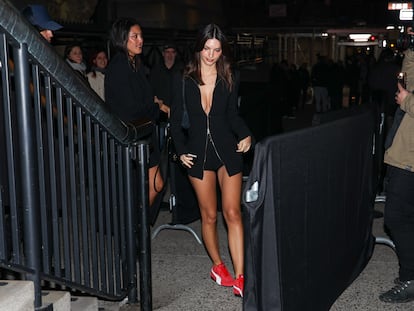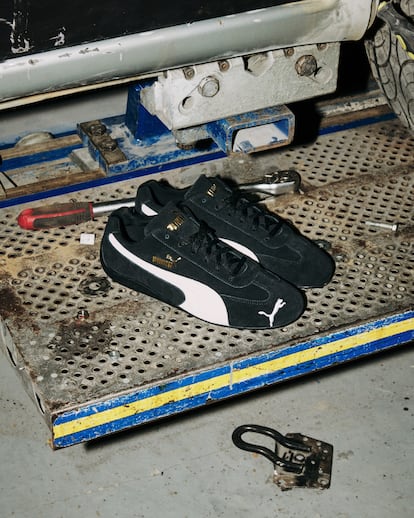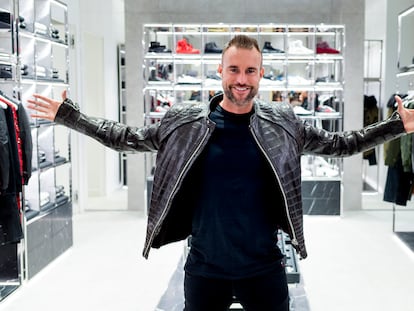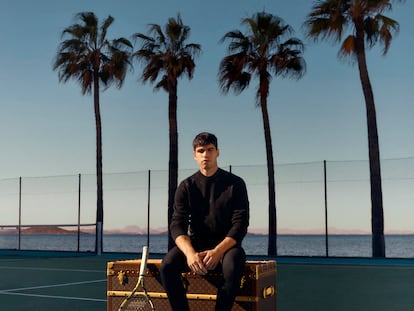Why the Puma Speedcat has every chance of becoming the shoe of the season
The brand’s collaboration with Sparco was an obsession two decades ago. 20 years later, it’s back, powered by fashion’s growing interest in motor sports

Every generation of fashionistas has its version of Proust’s madeleine and among those who were adolescents during the beginning of the 2000s, the time machine is Puma’s Speedcat sneaker. The bicolor design, created in collaboration with the brand Sparco, an Italian company that specializes in gear for racecars, has become, in the words of Alberto Turincio, head of PR and social influence sportstyle for Puma, “a bestseller and object of desire, one of the highest-selling shoes in the history of Puma.” Five years ago, the sneakers were remixed to celebrate the 20th anniversary of their launch, this time with the Sparco logo on the tongue. Still, their greatest revival is taking place right now, with a re-release on June 29 that maintains intact the aesthetic that led them to triumph 20 years ago. For the moment, they’ll be available in red and black.
The Sparco, as the standout shoes are known in the streets, widened their audience beyond fans of motorsports and conquered teens across the world, becoming the fashionable footwear for the high school set at the turn of the century. Profit reports from the German brand during those years serve to illustrate the size of this phenomenon. According to data published by the era’s press, Puma increased its revenues by 125% in 2001 and by 211% in 2003. Will it be able to match its success in 2024?
The sneaker-focused Instagram account @hartcopy wondered last December if the Sparco would be the shoe to end the reign of Adidas’s ubiquitous Samba. At the moment, the Speedcat has the approval of model Emily Ratajkowski, who seems to have been wearing hers for months. Expectations surrounding their return to the throne have been going viral on TikTok, where videos of how to style the Speedcat are proliferating, proof of its rediscovery by a generation that wasn’t even born when the original design revolutionized the market. The shoe’s re-release could not have landed at a more opportune time, with 2000s fashion shaping today’s most popular trends. Not to mention that in recent months, the world of motorsport has come into new prominence and the fashion industry, flexing its powerful ability to absorb any discipline currently arousing society’s interest, has been working on its link with the world of motor racing. Let’s not forget that the origin of these iconic shoes lies in Formula 1 racing.
From the racetrack to the streets
The origin of the popular shoes goes back to the 1980s, with the design of Puma’s first racecar shoes: the Motorsport model, high-cut leather boots designed in 1984 for the Formula 1 driver Stefan Bellof. The German, who died one year later in an accident during a race, won some high-profile victories in the shoes, which planted the seed for what would later become the Speedcat model, having been released to the market in 1999. The sporty shoe was designed “based on the flame-retardant shoes used by F1 drivers in 1998,” according to the brand.
How did a practical shoe different to every other model on the market at the time manage to captivate millions? As Alejandra De La Riva Sainz, chief marketing officer of specialty sneaker platform Foot District says, previous attempts to lure the masses to athletic shoes inspired by motorsports did not yield their promised bounty: “Until the arrival of the Puma Speedcat, footwear created for drivers was not in the streets. In the 1970s some moccasins that had nearly no sole became popular, they had rubber inserts that competition drivers used, but in the ‘90s, the only popular model that was linked to motorsports was what we call driving loafers. Nowadays, those are made by Prada, Tod’s and Sebago.” She adds that, “in the ‘70s, Nike gave it a shot through an alliance with Michael Schumacher, but it never created a real stir in the streets.” What was different this time? In Spain, one man, if indirectly, was responsible for the shoe’s success: Fernando Alonso. “Fernando Alonso, the first Spaniard to win a Formula 1 Grand Prix,” crowed the front page of EL PAÍS on August 25, 2003. The Asturian made history in the world of racing and set off a fandom phenomenon for the sport.
Races began to be shown on broadcast television during regular programming (for years, they were relegated to the wee hours of the morning or to pay channels). At first, it was Formula 1 fanatics who showed the most interest in shoes inspired by the footwear of their favorite drivers, but “a moment arrived in which style separated from performance and became a trend with a life of its own,” says De La Riva. Puma says that the brand has “seen an active search for these silhouettes.” The profile in question features a simple upper, with laces in the same hue as the sneaker, the monochrome aesthetic broken by the brand’s so-called formstrip (the curved band that crosses the side of its models), matching the Puma logo located on the toe. The real difference lies in the sole, which is raised to the heel and has a rather pneumatic look. According to Turnicio, this distinctive appearance was key to attracting consumers, who were won over by the “innovative design inspired by motor racing shoes,” adding that “its association with motorsport culture, backed by celebrities” strengthened its aura as a cool sneaker.

Motorsports and fashion, a fruitful alliance
The return of these sporty shoes is the umpteenth proof of the growing popularity of motorsports in fashion. Over the last two years, the sector appears to have found in Formula 1 unexplored territory with great potential. The turning point came in March 2022, when Motomami, Rosalía’s long-awaited third album, was released. Beyond its impact in the music industry, the work by the Catalan singer did not go unnoticed by the fashion industry. Its narrative and visual elements from the world of motorcycles left its mark. Some brands had already made some nods to this be-wheeled universe, as in Dior’s autumn-winter 2022-2023 collection, but in subsequent seasons, fashion went all in on tires and gasoline. Just take May 2022, when Chanel presented its “Cruise” fashion show in Monte Carlo, a city associated with the most exclusive in luxury, but also with Formula 1’s Monte Carlo Grand Prix. Two decades after Puma joined forces with Sparco, the sneaker brand not only relaunched their classic collaboration, but also embraced the visual strength of the motorcycle by linking up with independent brand Ottolinger. Drivers have become fashion icons, as per this recent headline in the U.S. edition of Vogue: “The Next Street Style Capital? The Formula One Paddocks.”
As he battles for his career’s 33rd win, Alonso was tapped to be the face of Boss last year. His rival on the racetrack, 20-year-old George Russell, is starting to collaborate with clothing brands, while Carlos Sainz Jr. has already starred on the pages of some of the most influential fashion magazines. Of course, Lewis Hamilton continues to dominate Formula 1 both in and out of his vehicle. In April, the Brit competed in the Shanghai Grand Prix and, upon his arrival, was photographed as a true street style star in a Louis Vuitton look. Shortly after, at the Miami Grand Prix, he posed with model Kendall Jenner, both dressed in Tommy Hilfiger, the brand for which the athlete is an ambassador. The Miami Grand Prix, which has been held since 2022, has grabbed the attention of many a celebrity, with hordes of stars attending the race as part of professional engagements that, in turn, enhance the visibility of the sport. At the last edition, held in mid-May, we saw Rihanna (supporting A$AP Rocky at an event promoting his collaboration with Puma), singer Camila Cabello and supermodels like Karolína Kurková, Taylor Hill and Candice Swanepoel, just in case you had any doubts that Formula 1 and the fashion industry have entered into symbiosis.
Going back to Tommy Hilfiger, the brand’s connection with the world of motorsports is far from a passing fancy. Hilfiger himself has confessed that he is a fan of the sport and his brand will be the official sponsor of the long-awaiting Formula 1 movie (its title has yet to be confirmed) starring Brad Pitt and Damson Idris, who, in a perfect marketing turn, is also a Hilfiger brand ambassador. On the big screen, motorsport themes could also be found in two projects from last year: Gran Turismo with Orlando Bloom and the Enzo Ferrari biopic, with Adam Driver and Penélope Cruz. The fever for Formula 1 rages, but the aesthetic still has room to grow in the world of fashion. It’s clear that the Puma Speedcat has a good chance of passing its competitors on the right.
Sign up for our weekly newsletter to get more English-language news coverage from EL PAÍS USA Edition
Tu suscripción se está usando en otro dispositivo
¿Quieres añadir otro usuario a tu suscripción?
Si continúas leyendo en este dispositivo, no se podrá leer en el otro.
FlechaTu suscripción se está usando en otro dispositivo y solo puedes acceder a EL PAÍS desde un dispositivo a la vez.
Si quieres compartir tu cuenta, cambia tu suscripción a la modalidad Premium, así podrás añadir otro usuario. Cada uno accederá con su propia cuenta de email, lo que os permitirá personalizar vuestra experiencia en EL PAÍS.
¿Tienes una suscripción de empresa? Accede aquí para contratar más cuentas.
En el caso de no saber quién está usando tu cuenta, te recomendamos cambiar tu contraseña aquí.
Si decides continuar compartiendo tu cuenta, este mensaje se mostrará en tu dispositivo y en el de la otra persona que está usando tu cuenta de forma indefinida, afectando a tu experiencia de lectura. Puedes consultar aquí los términos y condiciones de la suscripción digital.
More information
Archived In
Últimas noticias
Most viewed
- Sinaloa Cartel war is taking its toll on Los Chapitos
- Oona Chaplin: ‘I told James Cameron that I was living in a treehouse and starting a permaculture project with a friend’
- Reinhard Genzel, Nobel laureate in physics: ‘One-minute videos will never give you the truth’
- Why the price of coffee has skyrocketed: from Brazilian plantations to specialty coffee houses
- Silver prices are going crazy: This is what’s fueling the rally











































